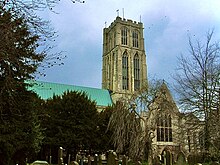Howden Minster
| Howden Minster | |
|---|---|

Howden Minster, East Riding of Yorkshire
|
|
| 53°44′43″N 0°52′02″W / 53.745300°N 0.867200°WCoordinates: 53°44′43″N 0°52′02″W / 53.745300°N 0.867200°W | |
| Denomination | Church of England |
| Churchmanship | Anglo-Catholic |
| Website | [1] |
| History | |
| Dedication | St Peter and St Paul |
| Administration | |
| Parish | Howden Minster |
| Deanery | Howden |
| Archdeaconry | East Riding |
| Diocese | York |
| Province | York |
| Clergy | |
| Rector | Rev James Little |
| Vicar(s) | Rev Graham Thornalley |
| Laity | |
| Organist/Director of music | Matthew Collins |
Howden Minster is a large Grade I listed Church of England church in the Diocese of York. It is located in Howden, East Riding of Yorkshire, England. It is one of the largest and most magnificent churches in the East Riding of Yorkshire. It is dedicated to St Peter and St Paul and it is therefore properly known as 'the Minster Church of St Peter and St Paul'. Its Grade I listed status also includes the Chapter House.
Howden Minster was owned by monks from Peterborough Abbey in Saxon times, but in 1080 it was gifted to William of Calais (Bishop of Durham). Although dependent on Durham, the minster was in the Diocese of York. Rebuilding the Norman church in the Early English style seems to have been begun in 1228. It became a Collegiate Church in 1267. Rebuilding work was completed in the Decorated style around 1340. A small octagonal Chapter House was built after 1388, the last of its kind to be built in England. The church survived the Dissolution of the Monasteries as it was not a monastery, but fell victim to the Dissolution of Collegiate Churches and Chantries in 1548.
Although the minster was not destroyed in the Dissolution, the choir or chancel was allowed to fall into ruin, and only the nave was used for services. The roof eventually collapsed in 1696, and the chapter house roof collapsed in 1750. The ruins are now in the guardianship of English Heritage, preserved by the Department of the Environment, and are in the condition of a 'safe ruin'. The chapter house received a new roof in 1984. The ruins can only be seen from the outside, as they are still part of the current minster church.
...
Wikipedia
